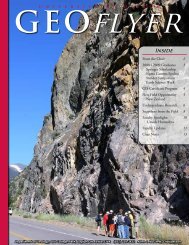Stander Symposium abstract book - University of Dayton
Stander Symposium abstract book - University of Dayton
Stander Symposium abstract book - University of Dayton
You also want an ePaper? Increase the reach of your titles
YUMPU automatically turns print PDFs into web optimized ePapers that Google loves.
POSTER SESSION 1<br />
similar phenotypes in LOF <strong>of</strong> defective proventriculus (dve), which encodes a homeobox protein. We investigated if dve plays a role in axial patterning<br />
during early eye development. We found that Gain-<strong>of</strong>-Function (GOF) <strong>of</strong> dve results in suppression <strong>of</strong> eye by downregulating Retinal Determination<br />
(RD) genes. We found that dve plays an important role in dorsal eye fate selection during early eye development. In the eye imaginal<br />
disc, Dve expression is restricted to a small region anterior to the Morphogenetic Furrow (MF) on the dorsal eye margin. This expression domain<br />
<strong>of</strong> Dve also overlaps with Wingless (Wg), which is expressed at the lateral margins <strong>of</strong> the developing third instar eye discs. Interestingly, we found<br />
that dve is required to maintain a Wg morphogen gradient in the developing Drosophila eye field to promote DV patterning <strong>of</strong> the Drosophila eye.<br />
Here we present insights into the novel role <strong>of</strong> dve in dorsal eye fate selection in the Drosophila eye.<br />
Domain specific E3 ubiquitin ligase mediated Wingless degradation promotes Dorso-<br />
Ventral lineage in the developing Drosophila eye<br />
Presenter(s): Meghana Tare<br />
Advisor(s): Amit Singh<br />
Biology - Graduate Research<br />
During early eye development, axial patterning transforms a single sheet <strong>of</strong> organ primordium cells to a three-dimensional organ by generating<br />
Dorso-ventral (DV), antero-posterior (AP), and proximo-distal (PD) axes. Drosophila eye anlagen initiates with a ventral ground state on which the<br />
dorsal eye fate is established, which requires a large number <strong>of</strong> eye specific proteins. Members <strong>of</strong> the Notch signaling pathway, Lobe (L; PRAS40<br />
in vertebrates) and Serrate (Ser; Jagged-1 in vertebrates), play an important role in ventral eye growth and development. Loss <strong>of</strong> function <strong>of</strong> L/<br />
Ser results in loss <strong>of</strong> ventral half <strong>of</strong> the eye. In a genetic modifier screen, cullin-4 (cul-4) was identified as a modifier <strong>of</strong> L mutant phenotype in the<br />
ventral eye. cul-4 encodes an E3 ubiquitin ligase - an enzyme that ligates ubiquitin molecules to the proteins targeted for degradation. However,<br />
the pathway through which cul-4 exerts its effects on L is not known. Using Drosophila eye as a model system, we characterized the functions <strong>of</strong><br />
cul4, and its interactions withL using loss and gain <strong>of</strong> function approaches. Our studies suggest that cul-4 acts downstream <strong>of</strong> L, and promotes cell<br />
survival in the ventral region <strong>of</strong> the developing eye by targeting Wingless (Wg) signaling components for degradation. Here we present a novel<br />
mechanism <strong>of</strong> DV specific ubiquitin mediated protein degradation that promotes and maintains dorsal ventral (DV) lineage in the developing<br />
early eye field.<br />
Effects <strong>of</strong> Dietary Regimen on Lifespan and Fecundity <strong>of</strong> Blow Fly, Lucilia sericata<br />
(Diptera: Calliphoridae)<br />
Presenter(s): Allissa M Blystone, Ryan M Huttinger, Connor Ratycz<br />
Advisor(s): Karolyn M Hansen<br />
Biology - Independent Research<br />
The green bottle fly, Lucilia sericata, is a forensically important organism that is used to determine post-mortem interval (PMI) in deceased<br />
individuals. Insect colonization and species succession on decaying organic material are well-characterized events with Lucilia sericata being<br />
one <strong>of</strong> the first species to colonize. Forensic methods for determination <strong>of</strong> PMI using insect developmental stages have been developed based on<br />
laboratory methods for culture <strong>of</strong> insect species but there is no standard method for laboratory culture <strong>of</strong> Lucilia with respect to diet. This study<br />
focuses on the role <strong>of</strong> diet in the development <strong>of</strong> the blow fly, Lucilia sericata. Flies were reared using three common laboratory dietary regimens:<br />
1. Honey-Water and Water, 2. Liver and Water, and 3. Granular Sucrose and Water. For each dietary treatment, three replicate cages <strong>of</strong> 15 male<br />
flies and 15 female flies were run simultaneously. Developmental metrics were recorded (survivorship, number <strong>of</strong> eggs oviposited per event, and<br />
number <strong>of</strong> oviposition events) over the course <strong>of</strong> the study and data were analyzed to determine which diet was most efficient for fly maintenance<br />
and reproduction. Analyses revealed that flies fed honey-water and water lived an average <strong>of</strong> 37 days but did not lay any eggs. Flies fed liver and<br />
water lived an average <strong>of</strong> 22 days and laid an average <strong>of</strong> 300 eggs per cage. Flies fed sucrose flies lived an average <strong>of</strong> 30 days, but similar to the<br />
honey-water treatment, no eggs were laid. These results indicate that a protein source is necessary for the female egg production and support the<br />
premise that standard laboratory culture methods are a critical link between establishment <strong>of</strong> a standard developmental life cycle pattern and<br />
application <strong>of</strong> life cycle staging in forensic determination <strong>of</strong> PMI. Future research will focus on refinement <strong>of</strong> a standard balanced laboratory diet.<br />
25

















